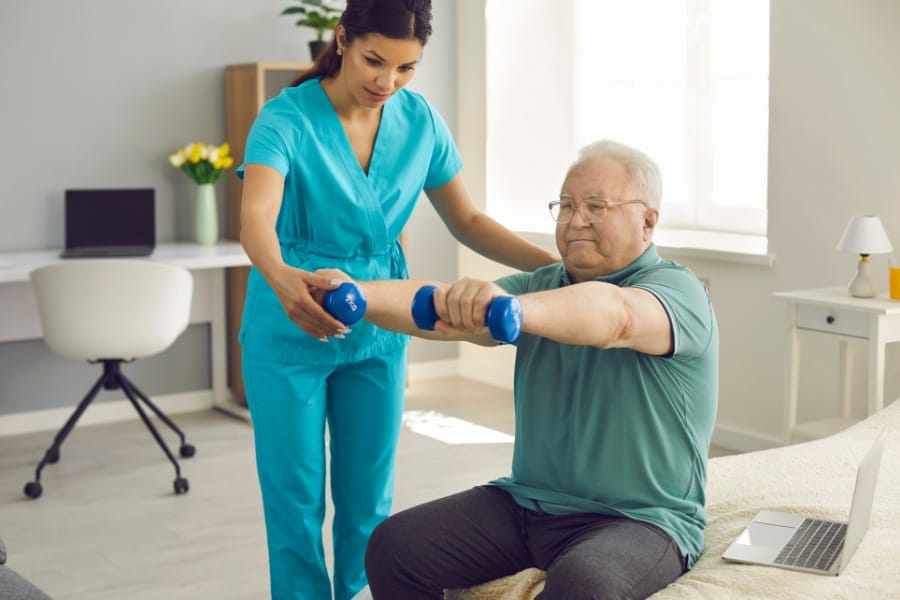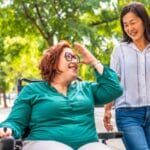The United States is already experiencing considerable growth in its senior population.
In 2050, the population of people over the age of 65 is projected to be 83.7 million—almost double its estimated population of 43.1 million in 2012. The baby boomers are largely responsible for this increase in the older population, as they began turning 65 in 2011.
By 2050, the surviving baby boomers will be over the age of 85.
The aging of the population will have wide-ranging implications for the country, including care of this population, both informally by loved ones and formally by nurses and various elderly living situations.1
Therefore, choosing home nursing for older people is a powerful option to increase peace of mind and convenience.
Chronic Conditions
IN THIS ARTICLE

As seen below, the majority of individuals over the age of 65 have a chronic condition requiring medication, assistance, or both, and can be a major predictor of needing assistance from another individual for daily functionality.
Condition % of Age 65+ Population2
High Blood Pressure58%
High Cholesterol 45%
Ischemic Heart Disease 31%
Diabetes 28%
Heart Failure 16%
Chronic Kidney Disease 15%
Depression 14%
COPD 12%
Alzheimer’s Disease 11%
Atrial Fibrillation 8%
Cancer 8%
Osteoporosis 7%
Asthma 5%
Stroke 4%
What should be noted, however, is that a majority of the senior population have 2 or more of these chronic conditions, with over a third of them having four or more of these conditions; thus requiring greater care and awareness of those living with them or caring for them.
Number of Chronic Conditions % of Age 65+ Population3
0 to 1 32%
2 to 3 32%
4 to 5 23%
6+ 13%
The greatest issue for individuals with six or more chronic conditions is that they may require the assistance and intervention of a Private Duty Nurse more than once per month.
Number of Chronic Conditions % with 13+ Home Health Visits by a Nurse4
0 to 1 <1%
2 to 3 3%
4 to 5 9%
6+ 27%
As will be seen in the following sections, the number of chronic conditions is a major preceptor in consideration of utilizing nurses for home care of the elderly.
Role of Home Nursing in Chronic Conditions

Home nursing plays an important role in supporting patients with chronic conditions such as diabetes, stroke, dementia, Alzheimer’s disease, Parkinson’s Disease, heart failure, COPD, and cancer.
Professional home nursing can help patients manage their conditions and improve their quality of life.
Nurses can provide a range of services to patients with chronic conditions, including monitoring vital signs, administering medications, providing wound care, and managing symptoms.
They can also educate patients and their families about the condition, its management, and the importance of adhering to treatment plans.
Diabetes
For patients with diabetes, home nursing can help monitor blood sugar levels, administer insulin, and provide education on diet and exercise.
Strokes
For patients recovering from a stroke, home nursing can help with mobility, speech therapy, and activities of daily living.
Dementia/Alzheimer’s Disease
For patients with dementia or Alzheimer’s disease, home nursing can provide support for memory loss, communication difficulties, and behavioral problems.
Home nursing can also be beneficial for patients with heart failure, COPD, and cancer. For patients with heart failure, home nursing can help with medication management, symptom control, and lifestyle changes.
For patients with COPD, home nursing can provide support for breathing difficulties, medication management, and oxygen therapy. For patients with cancer, home nursing can help with symptom management, wound care, and emotional support.
Demographics of the Elderly in terms of ADL and IADL5
Activities of daily living (ADLs) are basic self-care tasks, akin to the kinds of skills that people usually learn in early childhood. They include:
- Feeding
- Toileting
- Dressing
- Grooming
- Using the Bathroom
- Bathing
ADLs are often mentioned by geriatric-care professionals in connection with Instrumental Activities of Daily Living, or IADLs, which are slightly more complex skills. Instrumental Activities of Daily Living are the complex skills needed to successfully live independently. These skills are usually learned during the teenage years and include the following:
- Managing finances
- Handling transportation
- Shopping
- Preparing meals
- Using the telephone and other communication devices
- Managing medications
- Housework and basic home maintenance
Together, ADLs and IADLs represent the skills that people usually need to be able to manage in order to live as independent adults. When the elderly start having limitations of both the number of ADLs and IADLs that can be performed independently, this is a secondary sign of not only needing help from a family caregiver informally but a sign that more formal training from a Nurse may be required on a daily basis, depending on the limitation.
When Professional Nursing Help is Required

Chronic conditions, as those conditions that last a year or more, and require ongoing medical attention and/or Activities of Daily Living limitations are the greatest pitfalls that may require the use of a Nurse, where the limited ability and time of an informal caregiver is not enough.
Most of the utilization is by people with two or more chronic conditions, and most often seen in the following situations:
- 80% of home health
- 67% of prescriptions
- 48% of physician visits
- 56% of inpatient hospital stays.6
In fact, there are currently two million seniors with two or more ADL impairments, and, whether moderate or severe, are considered the potential long-term care population through regular home health visits, assisted living, or nursing home care.
The functional limitations of impaired elders are further complicated by poor health status and the struggle to cope with medical problems. Functional disability is associated with the increased presence of debilitating chronic conditions and increased reliance on medical care.
Nearly three-quarters (73%) of impaired elderly people are in fair or poor health, compared to less than a third (32%) of the general elderly population. These elders suffer from chronic health problems such as diabetes, heart disease, arthritis, and hypertension more widely than is true for the general elderly population.
This poorer health status translates into higher use of medical care. Impaired elderly people are much more likely to have received physician or home care services or to have been hospitalized within the past year than are other elderly people.7 As a result, the impaired population is five times as likely to use home health or in-home nursing services as the general elderly population.8
Yet, over a quarter (29%) of impaired elderly people live alone despite their disability and need for assistance. As severity of impairment increases, these elders are less able to continue to live alone, which could be a major factor causing them to move in with others or into institutions.
It is still striking that more than one in four elderly people with multiple impairments live alone. For this group, the absence of a resident caregiver is likely to result in a greater need for formal home care services.9
Now, let’s dive into the signs that senior nursing may be needed.
Signs That Professional Home Nursing Help is Needed
As people age, they may require more assistance with daily activities. While many seniors prefer to stay in their own homes, they may need professional home nursing help to maintain their independence and quality of life. Here are some signs that indicate it may be time to consider professional home nursing help:
Activities of Daily Living (ADLs)
ADLs are the basic activities that people need to perform to take care of themselves.
These include tasks such as bathing, dressing, grooming, and toileting. If a person is having difficulty performing these tasks, it may be time to consider professional home nursing help.
Instrumental Activities of Daily Living (IADLs)
IADLs are the more complex activities that people need to perform to live independently.
These include tasks such as managing finances, preparing meals, and doing housework. If a person is having difficulty performing these tasks, it may be time to consider professional home nursing help.
Self-Care
Self-care is an important aspect of maintaining one’s health and well-being.
If a person is having difficulty with self-care tasks such as taking medications, managing chronic conditions, or maintaining a healthy diet, it may be time to consider professional home nursing help.
Vital Signs
Monitoring vital signs is an important part of managing many health conditions.
If a person is having difficulty monitoring their vital signs or needs help with medication management, it may be time to consider professional home nursing help.
Health Monitoring
Regular health monitoring is important for managing many chronic conditions. If a person needs help with monitoring their health or managing their condition, it may be time to consider professional home nursing help.
Check out our guide on how to identify a high-quality nurse staffing agency here.
Types of Help for Elderly Care
Annually, 8.3 million people receive support from the 5 main long-term care services that nurses provide.
Types of Home Nursing Services

When it comes to home nursing services, there are a variety of options available to those who need them. Some of the most common types of home nursing services include:
Personal Care
Personal care is one of the most common types of home nursing services. It involves helping patients with activities of daily living such as bathing, dressing, grooming, and using the toilet.
Personal care can also include assistance with mobility, such as getting in and out of bed or a wheelchair.
Medication Management
Medication management is another important aspect of home nursing services. This involves ensuring that patients are taking their medications as prescribed and monitoring them for any adverse reactions.
Home nurses can also help patients with medication administration, such as giving injections or helping with inhalers.
Wound Care
Home nurses are often trained in wound care and can provide assistance with dressing changes, wound cleaning, and other aspects of wound care.
This can be especially important for patients who have chronic wounds or who are recovering from surgery.
Companionship
Home nursing services can also include companionship. This involves spending time with patients, engaging in conversation, and providing emotional support. Companionship can be especially important for patients who are isolated or who live alone.
Home Health Care Services
Home health care services are another type of home nursing service. These services can include a wide range of medical care, such as physical therapy, occupational therapy, and speech therapy.
Home health care services can also include nursing care, such as wound care and medication management.
Stress of Caregivers
Two out of three (66%) of older people with disabilities who receive Medicare Long-Term Service and Supports (LTSS) at home get all their care exclusively from their family caregivers, mostly wives and daughters.
Another quarter (26%) receives some combination of family care and paid help; only 9% receive paid help alone.14 Even among the most severely disabled older persons living in the community, about two-thirds rely solely on family members and other informal help, often resulting in great strain for the family caregivers.15
As a result, family caregivers often feel unprepared to provide care, have inadequate knowledge to deliver proper care, and receive little guidance from formal healthcare providers.16-18
Nurses and family caregivers rarely agree about specific needs or problems during hospital admission or discharge, in part because nurses are often unaware of the strengths and weaknesses of both the patient and caregiver.
Due to inadequate knowledge and skill, family caregivers may be unfamiliar with the type of care they must provide or the amount of care needed.19 Family caregivers may not know when they need community resources, and then may not know how to access and best utilize available resources.20
As a result, caregivers often neglect their own healthcare needs in order to assist their family members, causing deterioration in the caregiver’s health and well-being.21-23
Among the health issues that affect caregivers of the elderly are:
- Depression and anxiety: Women who are caregivers are more likely than men to develop symptoms of anxiety and depression.24 Anxiety and depression also raise your risk for other health problems, such as heart disease and stroke.
- Weak immune system: Stressed caregivers may have weaker immune systems than non-caregivers and spend more days sick with the cold or flu.25 A weak immune system can also make vaccines such as flu shots less effective. Also, it may take longer to recover from surgery.
- Obesity: Stress causes weight gain in more women than men.26 Obesity raises your risk for other health problems, including heart disease, stroke, and diabetes.
- Higher risk for chronic diseases: High levels of stress, especially when combined with depression, can raise your risk for health problems, such as heart disease, cancer, diabetes, or arthritis.
- Problems with short-term memory or paying attention:27 Caregivers of spouses with Alzheimer’s disease are at higher risk for problems with short-term memory and focus.
When to Call for Help
Eventually, most caregivers will realize there comes a point where they require the help and assistance of a formal Nurse in terms of caregiving for an elderly loved one. The principle areas that will help decide when this should be done is shown below:
- Wandering: In the later stages of dementia, the risk posed by wandering becomes much greater. They can wander even if you just take the time to go to the bathroom and the probability of falls and injuries increases.28
- Sundowning: “Sundowner syndrome” — very agitated behavior that becomes more pronounced later in the day — is a common characteristic of those with Alzheimer’s. This can take a heavy toll on caregivers, and when it begins to severely disrupt family routines, this may be a sign that the caregiving burden is too hard to handle.
- Aggression: Verbal, physical, and even sexual aggression frequently happens in those with dementia, and caregivers and other family members may suffer or begin to feel resentful. When they’re getting to that state, it’s time to start considering placement.
- Home safety issues: Ask yourself honest questions about your senior family member’s health and your own abilities to care for them. Is the person with dementia becoming unsafe in their current home?
- Escalating care needs: Is the health of the person with dementia or my health as a caregiver at risk? Are the person’s care needs beyond my physical abilities? If you’re answering yes to those questions, it might be time to have that tough family conversation.
Of all the potentially treatable subject characteristics, bowel incontinence was the only one that was associated with a higher rate of institutionalization in this population, with an increase of 42% more likely to be institutionalized when incontinence occurs on a frequent and regular basis.
Benefits of Home Nursing
Home nursing care provides numerous benefits for patients who require medical assistance at home. Here are some of the key benefits:
Greater Independence
One of the primary benefits of home nursing care is that it helps patients maintain their independence.
Patients who receive home nursing care can continue to perform everyday tasks like bathing, dressing, and preparing meals, which can help them maintain their quality of life.
Improved Quality of Life
Home nursing care can help improve a patient’s quality of life by providing personalized care in the comfort of their own home. Patients who receive home nursing care can avoid the stress and discomfort of hospital stays, which can help them feel more comfortable and relaxed.
Prevention of Infections
Home nursing care can help prevent infections by providing a clean and sterile environment for patients.
Patients who receive home nursing care can avoid exposure to hospital-acquired infections, which can help them recover more quickly and effectively.
Increased Flexibility
Home nursing care provides patients with greater flexibility in terms of scheduling and care. Patients who receive home nursing care can receive care on their own schedule, which can help them maintain their daily routines and activities.
Better Care for All
While a majority of healthcare services to the elderly are provided primarily by informal helpers, such as spouses and adult children, this providing of free care to an elderly relative often restricts the personal life, social life, and employment of the caregiver.
Caregivers may have less time to spend with friends, fulfill other family obligations, or pursue leisure pursuits and are often faced with difficult caregiving tasks and behavior problems of demented care recipients, such as verbal and physical aggression and confusion.
The role of the Nurse in the formal care setting of the elderly should be made aware to all caregivers, through both their elderly loved one’s physicians as well as other marketing and communication mechanisms.
In the end, if the loved one develops a level of stress that it affects their well-being, it will also reduce their ability to care for their loved one; hence the need for formal care by Nurses trained in these geriatric services.31
At NurseRegistry, we offer wellness checks, medication management, post-hospital care, respite care, and other skilled services. If you have a senior loved one who could benefit from a private duty nurse, click below or call 650-462-1001 to speak with one of our Care Coordinators.
Frequently Asked Questions
What are some examples of situations where in-home nursing care is needed?
In-home nursing care is needed when a patient requires medical attention but prefers to stay at home instead of being admitted to a hospital or nursing facility. Some examples of situations where in-home nursing care may be needed include recovering from surgery, managing a chronic illness, receiving palliative care, or dealing with a terminal illness.
What types of patients typically require home health services?
Patients who typically require home health services are those who have a medical condition that requires skilled nursing care or therapy, or those who need assistance with daily living activities, such as bathing, grooming, and dressing. These patients may include elderly individuals, those with chronic illnesses or disabilities, or those recovering from surgery or an injury.
What is the difference between a home health aide and a nurse?
A home health aide provides non-medical assistance with activities of daily living, such as bathing, dressing, and meal preparation. A nurse, on the other hand, provides skilled medical care, such as administering medications, wound care, and monitoring vital signs.
References
1 Ortman, J., “An Aging Nation: The Older Population in the United States,” U.S. Census Bureau, May 2014.
2-4 “Chronic Conditions Among Medicare Beneficiaries,” Center for Medicare and Medicaid Services, 2012
5 Kernisan, Leslie, “Activities of Daily Living: What Are ADLs and IADLs?” Caring.com, May 24, 2016.
6 Hwang W, Weller W, Ireys H, Anderson G., “Out of pocket medical spending for care of chronic conditions,” Health Affairs, 2001;20:268-9.
7 Partnership for Solutions. Chronic conditions: making the case for ongoing care, Baltimore: The Johns Hopkins University; 2002.
8 National Center for Health Statistics, The Supplement on Aging to the 1984 National Health Interview Survey, DHHS Pub. no. (PHS)87-1323 (Hyattsville, Md.: NCHS, 1987).
9 Rowland, Diane, “Measuring the Elderly’s Need for Home Care,” Health Affairs, Volume 8, Number 4, 1989, pp. 39-51.
10 Center for Disease Control and Prevention (2013) Long- Term Care Services.
11 Center for American Progress (2007) Caring about Long-Term Care.
12 National Alliance for Caregiving and AARP (2009) Caregiving in the U.S, National Alliance for Caregiving, Washington D.C .
13 Alzheimer’s Association and National Alliance for Caregiving. Families care: Alzheimer’s caregiving in the United States 2004. Washington, DC: Author, 2004.
14 Doty, P. (2010) The Evolving Balance of Formal and Informal, Institutional and non-Institutional Long-Term Care for Older Americans: a Thirty- Year Perspective. Public Policy & Aging Report 20, no.1
15 Data based on analysis of data from the 1994 and 1995 National Health Interview Surveys on Disability by Health Policy Institute, Georgetown University.
16 Bucher J, Loscalzo M, Zabora J, et al. +Problem-solving cancer care education for patients and caregivers,” Cancer Practitioner, 2001;9(2):66–70.
17 Scherbring M., “Effect of caregiver perception of preparedness on burden in an oncology population,” Oncology Nursing Forum, 2002;29(6):70–6.
18 Schumacher KL, Stewart BJ, Archbold PG, et al. “Family caregiving skill: Development of the concept,” Research in Nursing Health, 2000;23:191–203.
19 Rose JH, Bowman KF, Kresevic D., “Nurse versus family caregiver perspectives on hospitalized older patients: An exploratory study of agreement at admission and discharge,” Health Community, 2000;12(1):63–80.
20 Given B, Given CW, Stommel M, et al., “Predictors of use of secondary carers used by the elderly following hospital discharge,” Journal of Aging Health, 1994;6(3):353–76.
21 Given C, Stommel M, Given B, et al., “The influence of the cancer patient’s symptoms, functional states on patient’s depression and family caregiver’s reaction and depression,” Health Psychology, 1993;12(4):277–85.
22 Jepson C, McCorkle R, Adler D, et al., “Effects of home care on caregivers’ psychological status,”Journal of Nursing Scholarship, 1999;31(2):115–20.
23 Schulz R, Beach SR., “Caregiving as a risk factor for mortality: The caregiver health effects study,” JAMA, 1999;282:2215–9.
24 Mahoney, R., Regan, C., Katona, C., & Livingston, G, “Anxiety and depression in family caregivers of people with Alzheimer’s disease: the LASER-AD study,” American Journal of Geriatric Psychiatry, 2005, 13(9), 795–801.
25 Godbout, J. P., & Glaser, R. (2006), “Stress-induced immune dysregulation: Implications for wound healing, infectious disease, and cancer,” Journal of Neuroimmune Pharmacology, 2006, 1(4), 421–427.
26 Udo, T., Grilo, C. M., & McKee, S. A. , “Gender differences in the impact of stressful life events on changes in body mass index,” Preventive Medicine, 2004.
27 Vitaliano, P. P., Echeverria, D., Yi, J., Phillips, P. E., Young, H., & Siegler, I. C., “Psychophysiological mediators of caregiver stress and differential cognitive decline,” Psychology and Aging, 2005, 20(3), 402–411.
28 Stevenson, S., “How to Recognize Signs It’s Time for Assisted Living,” A Place for Mom, January 21, 2016.
29 Friedman, S., “Informal Caregivers and the Risk of Nursing Home Admission Among Individuals Enrolled in the Program of All-Inclusive Care for the Elderly,” The Gerontologist, 2006, Volume 46, Issue 4, pp. 456-463.
30 Miller, E. A., & Weissert, W. G., “Predicting elderly people’s risk for nursing home placement, hospitalization, functional impairment, and mortality: A synthesis,” Medical Care Research & Review, 2002, Volume 57 259-297.
31 Pinquart, M. , “Differences Between Caregivers and Noncaregivers in Psychological Health and Physical Health: A Meta-Analysis,” Psychology and Aging, July 2003, Volume 18, Number 2, pp. 250-267.






